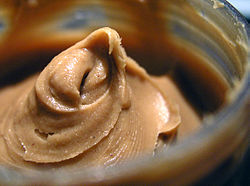This article needs additional citations for verification. (August 2021) |
A nut butter is a spreadable foodstuff made by grinding nuts, seeds or drupes into a paste. The result has a high fat content and can be spread like true butter, but is otherwise unrelated. Nut butters include:
 Peanut butter | |
| Type | Spread |
|---|---|
| Main ingredients | Nuts, seeds or drupes |
The almond, cashew, macadamia, peanut, pecan, pistachio and walnut are not true nuts in a botanical sense. However, because they are considered nuts in a culinary sense, their crushed spreads are called nut butters. Similar spreads can also be made from seeds that are not considered nuts in a culinary sense:
- Pumpkin seed
- Sesame seed (usually called tahini)
- Soybean – made from soynuts (roasted soybeans)[1]
- Sunflower seed
- Hummus or chickpea spread
Nut and seed butters have a high content of protein, fiber, and essential fatty acids, and can be used to replace butter or margarine on bread or toast. Nut butters can also be used as dipping sauces for apples and bananas, toppings for oatmeal or smoothie bowls, and ingredients in Asian sauces.
The grinding of nuts into a paste has a long history. Almond paste or marzipan was highly prized by the caliphs of Baghdad. The Kitab al-Tabikh or Book of Recipes was a collection of recipes from the court of ninth-century Baghdad. The most esteemed sweet was lauziinaq, an almond paste much like marzipan.[2] Hazelnut butter was mixed with chocolate to overcome shortages during the Napoleonic wars and WWII, which led to the invention of gianduja chocolate spreads (e.g. Nutella).[3]
Nutritional properties
editThe following table gives some approximate nutritional properties (for a reference serving of 1 tablespoon or approximately 15 grams) of some nut and seed butters. Many of these contain additional oils or other ingredients that may alter the nut butter's nutritional content.[4]
| Butter | Food energy kJ (kcal) |
Protein (g) |
Fat (g) |
Calcium (mg) |
Zinc (mg) |
|---|---|---|---|---|---|
| Almond butter | 420 (101) | 2.4 | 9.5 | 43 | 0.5 |
| Cashew butter | 390 (93) | 2.8 | 8 | 7 | 0.8 |
| Hazelnut butter | 390 (94) | 2 | 9.5 | N/A | N/A |
| Peanut butter – natural | 390 (94) | 3.8 | 8 | 7 | 0.4 |
| Peanut butter – reduced fat | 400 (95) | 4 | 6 | N/A | 0.4 |
| Sunflower butter | 330 (80) | 3 | 7 | N/A | N/A |
| Soy butter (sweetened) | 360 (85) | 4 | 5.5 | 50 | N/A |
| Soy butter (unsweetened) | 330 (80) | 4 | 6.5 | 30 | N/A |
| Soy-peanut butter (added sweetener) | 210 (50) | 2 | 1.2 | 40 | N/A |
| Tahini | 370 (89) | 2.6 | 8 | 64 | 0.7 |
See also
editReferences
edit- ^ Shurtleff, W.; Aoyagi, A.. 2012. "History of Soynuts and Soynut Butter... (1068–2012)." Lafayette, California: Soyinfo Center. 590 pp. (1,336 references, 114 photos and illustrations. Free online).
- ^ "Saudi Aramco World : Cooking with the Caliphs".
- ^ https://hazelnuthill.com/history-of-gianduja-chocolate-hazelnut-spread/ [dead link]
- ^ Reed Mangels (November–December 2001). "Guide to Nuts and Nut Butters". Vegetarian Journal. Retrieved 2006-08-07.